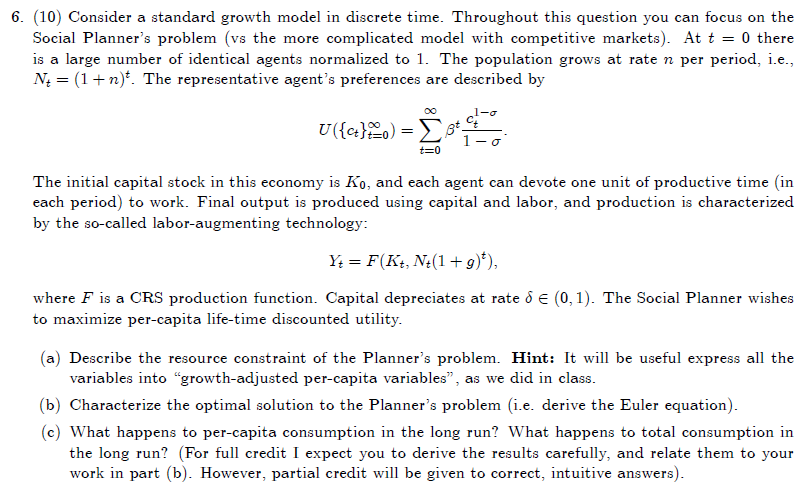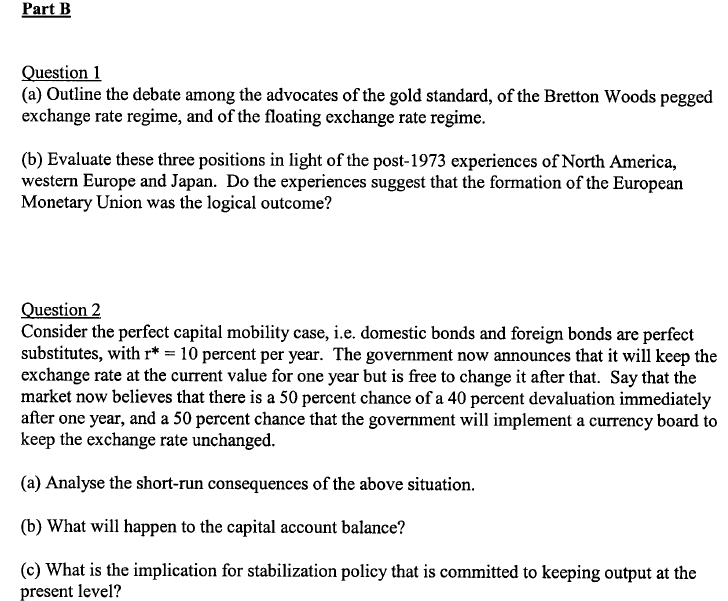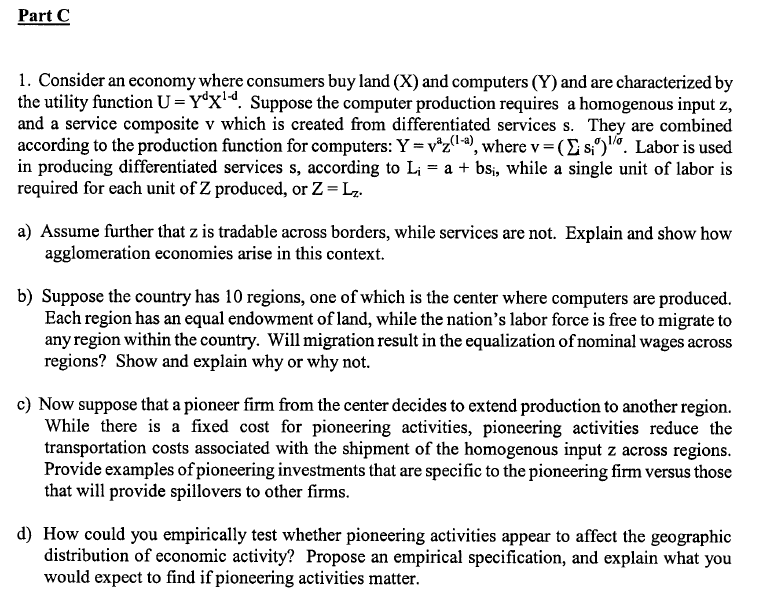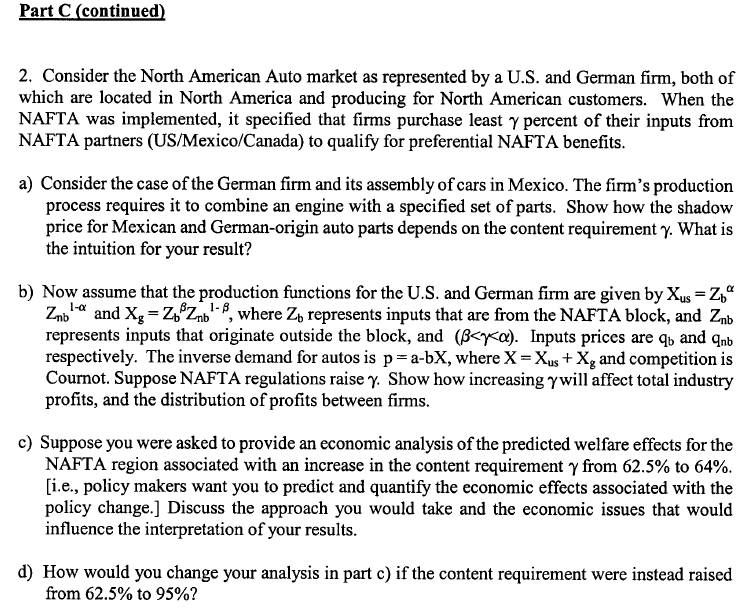




provide references where possible plz................
5. [20} Consider the standard MortensenPissarides model in continuous time. Labor force is normalized to 1. Unemployed workers, with measure a E 1, search for jobs, and rms with vacancies, with measure 1:, search for unemployed workers. The matching technology is given by m[u,n} = trawla. It is convenient to dene the market tightness H E 1: t A large measure of rms decide whether to enter the labor market with exactly one vacancy. \"Then a rm meets an unemployed worker a job is formed. The output of a job is p per unit of time. However, while the vacancy is unlled, rms have to pay a search or recruiting cost equal to pa per unit of time. In an active match (job), the rm pays the worker a wage to per unit of time, which is determined through Nash bargaining when the two parties rst match. Let ,5 represent the worker's bargaining power. The destruction rate of existing jobs is exogenous and given by the Poisson rate )L Once a shock arrives, the rm closes the job down. Subsequently, the worker goes back to the pool of unemployment, and the rm exits the labor market. Unemployed workers get a benet of 2: I} D per unit of time. Throughout this question focus on steady state equilibria and let the discount rate of agents be given by \"r. So far this is just the model we described in class. \"mat is new here is that the unemployment benet 2: does not stand for the utility of leisure or the value of home production, as is conveniently assumed in the baseline model. Here, .3 is a payment [in terms of the numeraire good} that the government delivers to the unemployed. Clearly, the government must tax someone in order to raise funds for the unemployment benets, and we assume that it raises these funds by levying a lumpsum tax equal to T [per unit of time] on every employed worker. Hence, the government chooses both 2: and T, and must do so in a way that keeps the budget constraint satised at all times. {a} Describe the Beveridge curve {BC} of this economy. {1:} Describe the value functions for a vacant rm {V} and a rm with a lled job (J). {c} 'What condition does J satisfy in equilibrium? Use your answer, together with your ndings in part {b}, to derive the job creation {JG} condition. {:1} Describe the value functions for an unemployed {U} and an employed {W} worker. {e} Describe the wage curve [1W0] in this economy. This will be a function of the usual terms and the new term T. E. {10} Consider a standard growth model in discrete time. Throughout this question you can focus on the Social Plannerls problem {vs the more complicated model with competitive markets}. At t = [I there is a large number of identical agents normalized to 1. The population grows at rate are. per period, i.e., Ni 2 {1 + 11):. The representative agent's preferences are described by lor at 10- Ulltli'iu} = 23* 20 The 1n1t1al capital stock in this economy,r is Kn, and each agent can devote one unit of productive time {in each period} to work. Final output is produced using capital and labor, and production is characterized by the socalled laboraugmenting technology: 1'3: = Fill-\"Q, Ntlll + Eli}, where F is a CR3 production function. lCapital depreciates at rate 5 E (D, 1]. The Social Planner wishes to maximize percapita lifetune discounted utility. {a} Describe the resource constraint of the Plannerls problem. Hint: It will be useful express all the variables into \"growthadjusted percapita variables", as we did in class. {b} Characterize the optimal solution to the Plannerls problem {i.e. derive the Euler equation}. {c} What happens to percapita consumption in the long ru.n'iI \"That happens to total consumption in the long run'? [For full credit I expect you to derive the results carefully, and relate them to your work in part (b). However, partial credit will be given to correct, intuitive answers}. ME Qgestion l (a) Outline the debate among the advocates of the gold standard, of the Bretton Woods pegged exchange rate regime, and of the oating exchange rate regime. {b} Evaluate these three positions in light of the post-1973 experiences of North America, westem Europe and Japan. Do the experiences suggest that the formation of the European Monetary Union was the logical outcome? EMon 2 Consider the perfect capital mobility case, in domestic bonds and foreign bonds are perfect substitutes, with r\" = 10 percent per year. The government now armouuces that it will keep the exchange rate at the current value for one year but is free to change it after that. Say that the market new believes that there is a 50 percent chance of a 40 percent devaluation innnediately after one year, and a 50 percent chance that the government will implement a currency board to keep the exchange rate unchanged. {a} Analyse the short-run consequences of the above situation. (b) What will happen to the capital account balance? {c} What is the implication for stabilization policy that is committed to keeping output at the present level? Part C 1. Consider an economy where consumers buy land {X} and computers (Y) and are characterized by the utilityr function U = YdXH. SuppOSe the computer production acquires a homogenous input 2., and a service composite v which is created from differentiated services s. The};r are combined according to the production function for computers: Y = wail\"), where v = i I.- si\")\"". Labor is used in producing differentiated services s, accorng to Li = a + bsi, while a single unit of labor is required for each unit of Z produced, or Z = L1. a) Assume further that sis Iradable across borders, while services are not. Explain and show how agglomeration economies arise in this context. b) Suppose the countryr has it] regions, one of which is the center where computers are produced Each region has an equal endowment of land, while the nation's labor force is free to migrate to anpr region within the country. Will migration result in the equalization of nominal wages across regions? Show and explain why or whyr not. c} Now suppose that a pioneer rm from the center decides to extend production to another region. While there is a xed cost for pioneering activities, pioneering activities reduce the transportation costs associated with the shipment of the homogenous input 2 across regions. Provide examples of pioneering investments that are specic to the pioneering rm versus those that will provide spillovers to other rms. cl) How could you empirically test whether pioneering activities appear to affect the geographic distribution of economic activity? Propose an empirical specication, and explain what you would expect to nd if pioneering activities matter.
















